Food-Info.net> Products > Tea
Tea varieties
Below a number of common tea varieties/specialties are described. This list is only a selection. In addition to the list below, there are many local tea varieties in many different countries.
Bancha
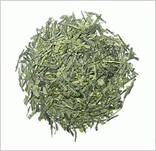
Bancha is the traditional tea of Japan . It is generated during the production of Sencha (see below) and is coarser, low in caffeine and rich in tannins.
Chun Mee
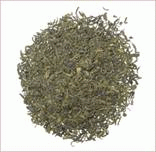
Green tea from China with long, rolled leaf.
Darjeeling
In the early 19th century, English colonials systematically established large plantations on the slopes of the Himalayas . The strong mountain sun and low night-time temperatures caused the leaves of the tea bushes to grow particularly slowly, resulting in the distinctive, mild aroma of this tea. Darjeeling tea ranks among the finest and most expensive varieties in the world.
Dimbula
Tea growing region in western Ceylon . Produces first-class high-grown teas.
Dooars
Tea growing region in Northern India, situated west of Assam, strong flavour reminiscent of Assam tea.
Dragon Pearl
Very rare and special tea with a hand-rolled, green leaf and Silver Tips (known also as Silver Needles).
English Breakfast
A blend characterized by English tastes. Always based on Assam and Ceylon teas.
Genmaicha
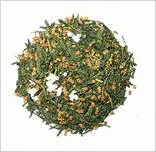
Japanese tea with roasted brown rice and popcorn. Pale brown liquor with pleasant aroma: slightly salty, grainy taste with a hint of sweetness.
Green Monkey
The Tai-Mu mountains to the north of the Chinese province of Fujian are home to this unusual tea which is made carefully by hand to give it its distinctive fresh, smooth character and white tips.
Green Mu Dan
Green tea rose. 50 young shoots are tied together by hand into a tea rose. Develops its full form and a fine, pleasant aroma when hot water is poured on.
Green Pekoe
From the Chinese province of Fujian ; thin, carefully rolled, tippy leaf. Fresh, pleasant taste and clear, pale-green liquor.
Gu Zhang Mao Jian
Chinese tea from the Wuyi mountains along the Quishui river. Slightly sweet, chestnutty character. Harvested for 10 days in spring and slightly fermented.
Gunpowder
Green tea variety with a hard, tightly rolled leaf. The leaves are rolled into homogeneous balls between the palm of the hand and the inside of the boiler.
Gyokuro
Japanese speciality. An exclusive tea known as "fine dewdrop" which is shaded with rice matting or foil weeks before the harvest to reduce the tannin and increase the caffeine content.
Hazelbank
This small, picturesque garden in the Indian region of Assam produces one of the best teas in the world. It is named after Hazel, daughter of the famous civil servant Dr. Mead. The fullness, size and colour of Hazelbank makes it a favorite among tea merchants.
Highgrown
Very pale teas with a delicate aroma grown in the mountain regions of Ceylon .
Hui Ming
Hui Ming tea takes its name from the Huiming temple of Jungning in the south of the Chinese province of Zhejiang . To coincide with the opening ceremony of the Panama canal in 1915, an international exhibition was held in San Francisco for which every country selected its finest products. The Chinese tea was voted best and received the gold medal. Since then it has been known widely as Gold Medal Hui Ming.
Jasmine tea
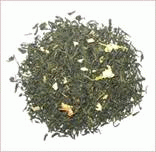
Probably the best known flavoured Chinese tea. Perfumed exclusively with tender white jasmine flowers. These lose their scent within 20 hours of picking, and therefore have to be added to the tea immediately to give it the desired aroma.
Java
Java produces strong, dark, tasty teas - mostly fannings - during the dry period. Premium qualities.
Keemun
Classic Chinese black leaf tea with a small, delicate leaf and a sweet aroma. Lower in caffeine than most other black teas. Used as component in various "Russian Teas" because of its low tannin level.
Kokicha
A Japanese specialty. The green tea is first pulverized before being recompressed by a special process and cut into small, longitudinal slices. Pleasantly fresh with a pale, mild liquor. Another version in this category is the "Small veins tea". Broken leaves are blend with fine-cut veins of the tea bush.
Kwai Flower
This Chinese tea gets the name Kwai Flower from the osmanthus blossom. Also from China, this is a sweet-smelling plant with a strong, aromatic taste. In China it is also used in the manufacture of various foodstuffs such as sugar and wine.
Lapsang Souchong
Classic Chinese black tea, flavoured with the smoke from pine tree roots.
Lung Ching
Green tea from China with a flat, long leaf. The leaves are first stetched with the fingers and then pressed flat.
Matcha
Japanese green powdered tea, mainly used for the Japanese tea ceremony.
Muscatel
A tea from the Darjeeling region, picked during the late second flush period.
Pai Mu Tan
Meaning "White Peony", this white tea has a delicate, flowery aroma. It is derived from the tip (Silver Needle) and the two most upper leaves of the plant, being jade green in colour, and is slightly steamed . See also White tea.
Pettiagalla
Exquisite taste. Long. wiry leaf, highly aromatic. The plantation is located at an altitude of 1,000 m in the district of Balangoda
Pi Lo Chun
"Green spring snail". Green tea with a wiry leaf which has a distinctive fresh scent and a fruity taste.
Pu Erh
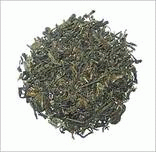
Pu Erh (Pou Nei) is a strong-flavoured tea with a fleshy leaf from the Chinese province of Yunnan . It gets its name from the town of Pu Erh, via which it is sold. It has a very earthy, pervasive aroma.
Pu Erh is produced according to highly traditional methods similar to those used approx. 2000 years ago in China.
Sencha
Sencha is probably the most poplar tea variety in Japan and has a long, flat leaf. Japanese Sencha has a fresh, slightly sweet taste, while Chinese Sencha is reminiscent of fresh hay and highly aromatic.
Silver Sprout
Silver sprout is a crescent-leafed tea with a yellow-green liquor and an extremely fresh, mild aroma.
Snow Buds
Green tea with white tips and a pleasant 'White Tea character', honey-coloured liquor. Mild, smooth taste. See also White Tea
White tea
White teas originate mainly from the mountainous regions of Fujian in Southern China . The leaves are slow and gentle steamed in the open air and very carefully handled.
Only the bud (Silver Needle) and two most upper leaves are plucked. Very low in tannin and caffeine. See also Pai Mu Tan.
Young Hyson
Chinese tea from the province of Zhejiang . The thick, yellowy-green leaves are rolled into a long, thin shape during processing. Produces an intense green liquor.
Yunnan
Yunnan is said to be the birthplace of tea. This province in south-eastern China still grows a strong-flavoured tea with a fleshy leaf and golden tips. Can have a slight similarity with Assam .
Source :
More information on tea :




